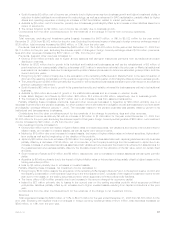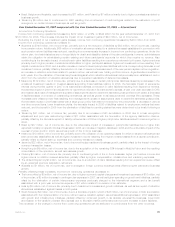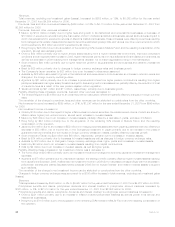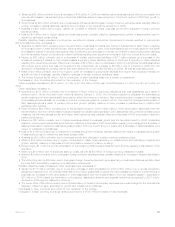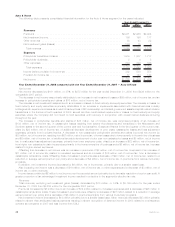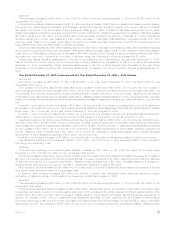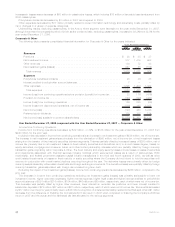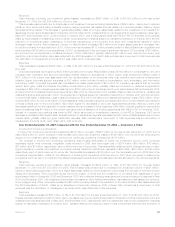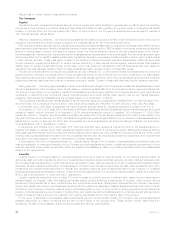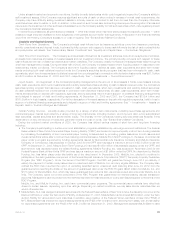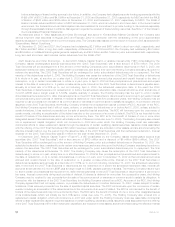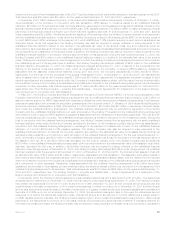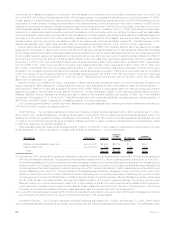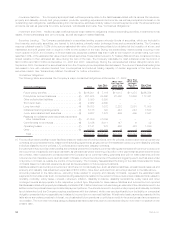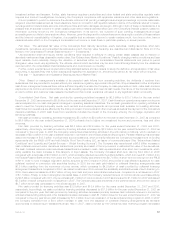MetLife 2008 Annual Report Download - page 50
Download and view the complete annual report
Please find page 50 of the 2008 MetLife annual report below. You can navigate through the pages in the report by either clicking on the pages listed below, or by using the keyword search tool below to find specific information within the annual report.cost or amortized cost of $20.8 billion and $41.1 billion and an estimated fair value of $22.9 billion and $42.1 billion were on loan under the
program at December 31, 2008 and 2007, respectively. Securities loaned under such transactions may be sold or repledged by the
transferee. The Company was liable for cash collateral under its control of $23.3 billion and $43.3 billion at December 31, 2008 and 2007,
respectively. Of this $23.3 billion of cash collateral at December 31, 2008, $5.1 billion was on open terms, meaning that the related loaned
security could be returned to the Company on the next business day requiring return of cash collateral and $14.7 billion and $3.5 billion are
due within 30 days and 60 days, respectively. The estimated fair value of the securities related to the cash collateral on open at
December 31, 2008 has been reduced to $5.0 billion from $15.8 billion at November 30, 2008. Of the $5.0 billion of estimated fair value of
the securities related to the cash collateral on open at December 31, 2008, $4.4 billion were U.S. Treasury and agency securities which, if
put to the Company, could be immediately sold to satisfy the cash requirements. The remainder of the securities on loan are primarily
U.S. Treasury and agency securities and very liquid residential mortgage-backed securities. The U.S. Treasury securities on loan were
primarily holdings of on-the-run U.S. Treasury securities, the most liquid U.S. Treasury securities available. If these high quality securities
that were on loan were put back to the Company, the proceeds from immediately selling these securities could be used to satisfy the
related cash requirements. The estimated fair value of the reinvestment portfolio acquired with the cash collateral was $19.5 billion at
December 31, 2008, and consisted principally of fixed maturity securities (including residential mortgage-backed, asset-backed,
U.S. corporate and foreign corporate securities). If the on loan securities or the reinvestment portfolio were to become less liquid, the
Company has the liquidity resources of most of its general account available to meet any potential cash demand when securities are put
back to the Company. Based upon present market conditions, management anticipates the securities lending programs will be maintained
in the $18 to $25 billion range. This estimate has been factored into the Company’s liquidity and investment plans. Management plans to
continue to lend securities and believes it has appropriate policies and guidelines in place to manage this activity at a reduced level through
this extraordinary business environment. See “— Investments — Securities Lending.”
Internal Asset Transfers. MetLife employs an internal asset transfer process that allows for the sale of securities among the business
portfolio segments for the purposes of efficient asset/liability matching. The execution of the internally transferred assets is permitted when
mutually beneficial to both business segments. The asset is transferred at estimated fair market value with corresponding gains (losses)
being eliminated in Corporate & Other.
During the fourth quarter of 2008, at a time of severe market disruption, internal asset transfers were utilized extensively to preserve
economic value for MetLife by transferring assets across business segments instead of selling them to external parties at depressed
market prices. Securities with an estimated fair value of $11.3 billion were transferred across business segments in the fourth quarter of
2008 generating $1.4 billion in net investment losses, principally within Individual and Institutional, with the offset in Corporate & Other’s net
investment gains (losses).
Collateral. The Company does not operate a financial guarantee or financial products business with exposures in derivative products
that could give rise to extremely large collateral calls. The Company is a net receiver of collateral from counterparties under the Company’s
current derivative transactions. With respect to derivative transactionswithcreditratingsdowngradetriggers,atwonotchdowngrade
would impact the Company’s derivative collateral requirements by less than $200 million at December 31, 2008. As a result, the Company
does not have significant exposure to any credit ratings dependent liquidity factors resulting from current derivatives positions.
Holding Company. The Holding Company relies principally on dividends from its subsidiaries to meet its cash requirements. None of
the Holding Company long-term debt is due before 2011, so there is no near-term roll-over risk. The Holding Company’s commercial paper
program, which amounts to $300 million at December 31, 2008, is kept active but is not used to fund on-going operating business
requirements. In addition to its other fixed obligations, the Holding Company has and may be required to pledge further collateral under
collateral support agreements if the estimated fair value of the related derivatives and/or collateral financing arrangements declines. The
Holding Company holds significant liquid assets of $2.7 billion at December 31, 2008. At December 31, 2008, the Holding Company had
pledged $820 million of liquid assets under collateral support agreements. See “— Investments — Assets on Deposit, Held in Trust and
Pledged as Collateral.”
Government Programs. The Company is participating in certain economic stabilization programs established by various government
institutions as described under “The Company — Liquidity and Capital Resources.”
Capital. This shift resulted in a relative increase in the cost of new debt capital and new credit. For example, in August 2008, MetLife
remarketed senior unsecured debt with a ten-year maturity at a 6.817% coupon. At December 31, 2008, the average coupon on ten-year
senior unsecured debt of the Holding Company, excluding the debt remarketed in August 2008, is 5.40%, or 1.40% less than that of the
debt remarketed in August 2008.
MetLife has no floating rate debt, other than that of the collateral financing arrangements of $5.2 billion which float based upon 3-month
LIBOR and the proceeds of which are invested in floating rate assets, and has issued $600 million in a single series of LIBOR-based
preferred stock with a 4% floor. This series represents a small portion of MetLife’s fixed charges. At current levels, LIBOR would have to
increase by 180 basis points (over 145% increase) to have any impact on the dividend for these preferred securities.
MetLife amended and restated certain of its credit agreements in December 2008. These changes included increases in pricing for
these agreements compared to the original rates.
In February 2009, the Holding Company closed the successful remarketing of the Series B portion of the junior subordinated
debentures underlying the common equity units. The Series B junior subordinated debentures were modified as permitted by their terms
to be 7.717% senior debt securities, Series B, due February 15, 2019. See “— Subsequent Events.” This issuance reflects a moderate
increase in the Company’s cost of borrowing.
As discussed above, market values experienced significant volatility during the third and fourth quarters of 2008. This market disruption
impacted unrealized gains and losses, which are included in accumulated other comprehensive income (loss). To strengthen our capital
position and increase our cushion against potential realized and unrealized losses in October 2008, the Company issued common stock
for gross proceeds of $2.3 billion to be used for general corporate purposes and potential strategic initiatives.
47MetLife, Inc.


